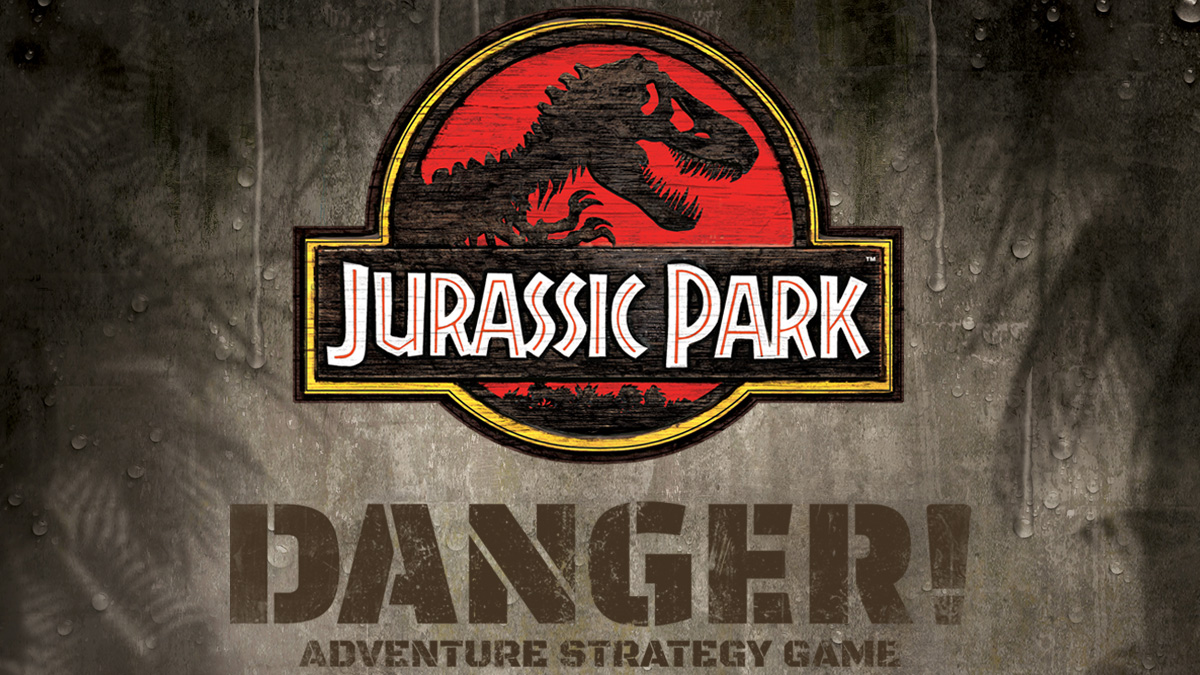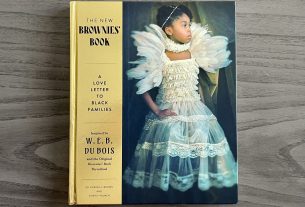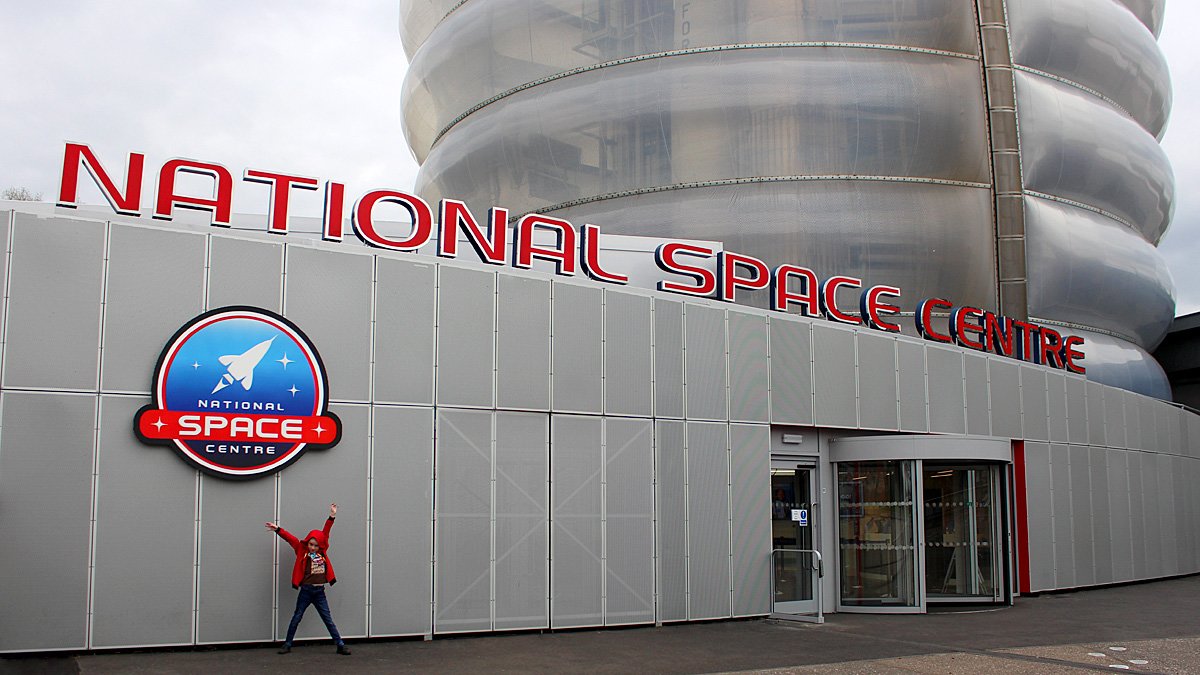
The National Space Centre in Leicester, UK, is an interactive museum dedicated to the past, present, and future of space exploration. My family was recently invited to spend the day there and explore all that the center has to offer.
Visiting the National Space Centre
The National Space Centre is divided into a number of zones including the Rocket Tower, Tranquility Base, and Space Oddities, as well as the usual cafe and gift shop. These are located around the central Sir Patrick Moore Planetarium where you can watch 360-degree immersive shows like CAPCOM Go! The Apollo Story, or a presenter-led tour of the night sky on weekends and during the school summer holidays.
Day tickets to the National Space Centre include one show at the planetarium, for those with annual passes or who want to see more than one show during their visit, additional tickets can be purchased on the day for £3 per person. My family was offered free access to the National Space Centre for our visit, but tickets to the National Space Centre cost £15 for adults and £12 for children and concessions, with children under five visiting for free. Parking costs £3 for the day.
In addition, booking in advance allows you to upgrade your day ticket to a free annual pass. This makes the National Space Centre one of the cheaper days out in the UK (in comparison, a nearby theme park costs £39 for adults and £29 for children) and the annual pass offer is great for families who live nearby.
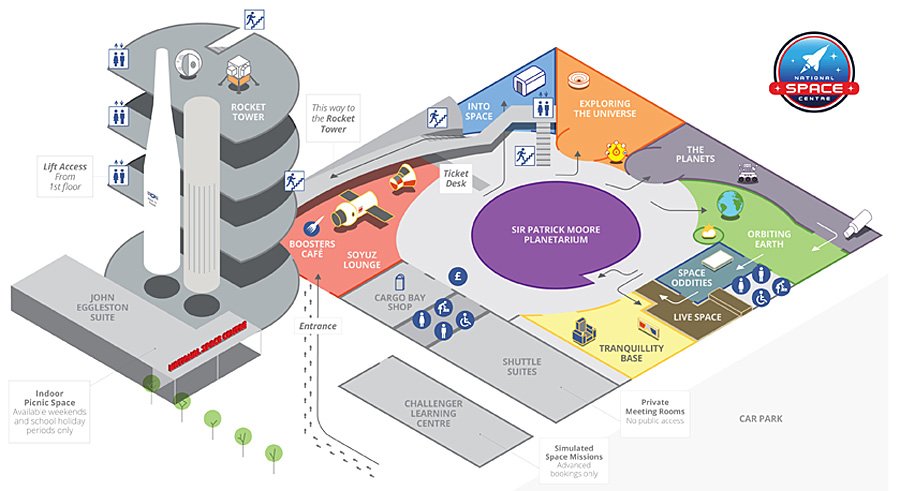
Facilities at the National Space Centre
The Boosters Cafe sells hot food, drinks, and snacks. We brought along our own food for our day trip and ate in the picnic area but we did stop by Boosters later in the day for drinks and cakes – all of which were delicious and reasonably priced. There is plenty of seating at Boosters and it remains open all day so if anyone in your party needs to take a break, this is a great spot.
The shop sells a wide variety of toys, clothes, books, and other space-themed items. My family can never leave a gift shop empty-handed and came away with magnets, patches, and postcards celebrating the 50th anniversary of Apollo 11.
The Rocket Tower
On approach to the National Space Centre, you cannot miss the Rocket Tower as it sticks up into the Leicester skyline. The Rocket Tower is home to the Blue Streak and Thor Able rockets and is mostly given over to the history of space travel with each level of the tower representing a different period in history.

Walls on two levels of the Rocket Tower are given over to enormous timelines that show events related to space travel and place them in a wider context of what was happening in the world at the same time. There is a recreation of a 1969 living room on the night of the Apollo 11 moon landing that my mum enjoyed looking around, a 1:8 scale moving model of the Lunar Module, an immersive video showing Soviet Firsts, and a selection of other items like an Apollo Fuel Cell on loan from the Smithsonian.
My son’s favorite part of the Rocket Tower was easily the Launch Simulator. This is split over two small rooms with one crew inside a small rocket capsule, and another crew at Mission Control. Both rooms are linked by a video feed from the capsule and can communicate via microphones. The crew at Mission Control must watch the displays and relay instructions to the rocket crew who must press buttons to get all systems ready for launch. When everything is green, the launch will commence and the capsule area fills with “smoke”. This is great when it is working properly but we found every time we tried, the system reset halfway through the simulation, sending us back to step one. This was very disappointing given that it had worked when we visited a few weeks before on a school trip, but my son enjoyed pressing the buttons and trying to coax it to work anyway.
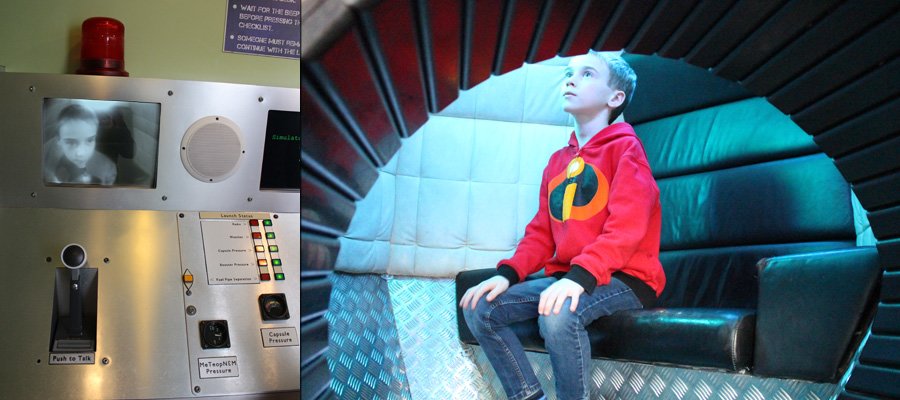
Some of the other activities and items in the Rocket Tower include a piece of moon rock, an old-fashioned replica cinema where you can watch the world’s first sci-fi film (La Voyage dans la Lune from 1902), bottle rocket launches, a display of missiles, and look at science fiction artifacts such as early copies of books by Jules Verne and HG Wells.
Into Space
The Into Space section of the National Space Centre concentrates on astronauts, with a specific focus on British astronaut Tim Peake. In this area, you can experience Tim’s journey to becoming an astronaut and ride with him to the International Space Station, see objects such as a space shuttle tire, and test your reactions and sensitivity to space sickness to see if you have what it takes to be an astronaut yourself. There’s also a scale model of the ISS suspended from the ceiling with a control panel that allows you to light up various sections and see what each part does.

My favorite part of the Into Space section is the full-size mock-up of the Columbus module of the International Space Station. Columbus is the European Space Agency’s laboratory aboard the ISS and you can walk inside and around this module and explore it. The Columbus mock-up includes many of the lab facilities found on the real Columbus module but also a sleeping compartment and shower so you can see what it’s like to live in space. There’s even a video screen embedded in the floor showing the Earth rotating below that you can stand beside and imagine what it would be like to look down on the Earth from above.
The Universe and Our Solar System
In these two sections, you get to explore the planets, watch the Big Bang, and learn about the ongoing search for extraterrestrial life. We all had a go at driving a Mars rover around on a simulated bit of Martian surface and stood aboard a ship bound for Venus in an impressive video-screen simulation. My son explored the Drake equation and learned about the life cycles of different kinds of stars, he also discovered how the weight of a standard can of beans differs depending on which planet you are standing on by lifting weighted cans on a display rack.
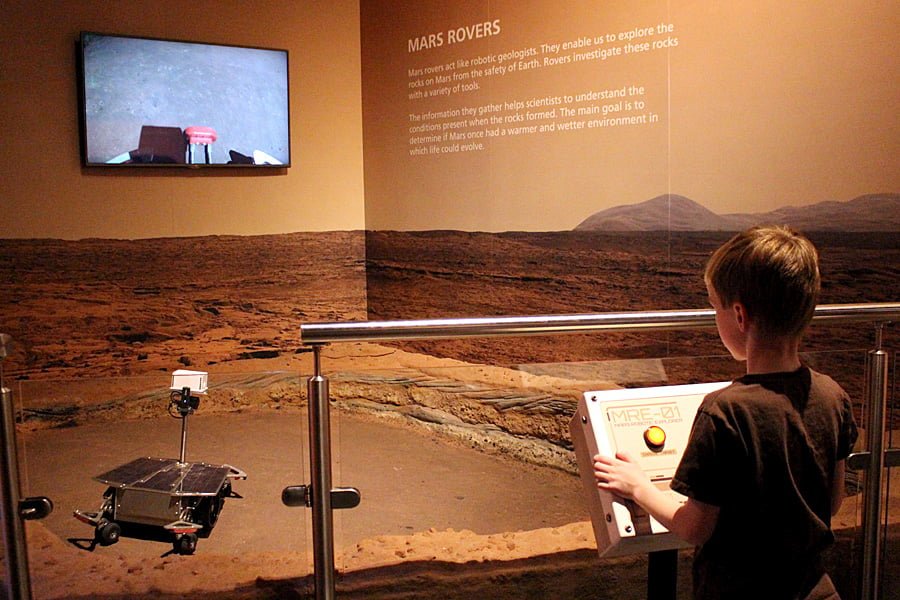
Each planet (and our moon) has its own dedicated area in this section that tells you facts and looks at previous missions to the planet. In the Stellarium you can walk around a model of the galaxy, lighting up different stars and seeing how our own sun fits in, and in another small room, you can sit and watch a video of the early universe to learn about the time immediately after the Big Bang. In the Alien Encounters area, you can see a replica of the gold record sent out on Voyager and listen to the different sounds that were recorded on it.
Orbiting Earth

The Orbiting Earth section looks at satellites, weather forecasting, and our changing planet. You can have a go at recording your own weather report against a green screen in the Weather Pod (this was the most popular activity when I supervised a school trip to the Centre earlier in the year), explore Near Earth Objects and their potential impact, and look at the enormous model of Earth which shows us how thin our atmosphere really is. To use the Weather Pod you will need a free paper pass with a barcode on it which allows you one turn in the Weather Pod and is also used in Tranquility Base, which I’ll get to later. Each member of your party will be given a pass on your arrival.
Space Oddities and Live Space
Space Oddities is a very small section that showcases unusual objects related to space exploration that don’t fit anywhere else. Some of the items in here included a copy of Buzz Aldrin’s Apollo 11 Quarantine Menu and a Lego model of a Saturn V rocket.
The Live Space area is where shows take place as well as teaching sessions for school visits. We attended a talk about Apollo 9 which looked at how rockets work using some hands-on demonstrations including launching a paper rocket through the side of a cardboard box and blasting a bottle rocket so high it was nearly caught in the rafters, much to the delight of watching children!
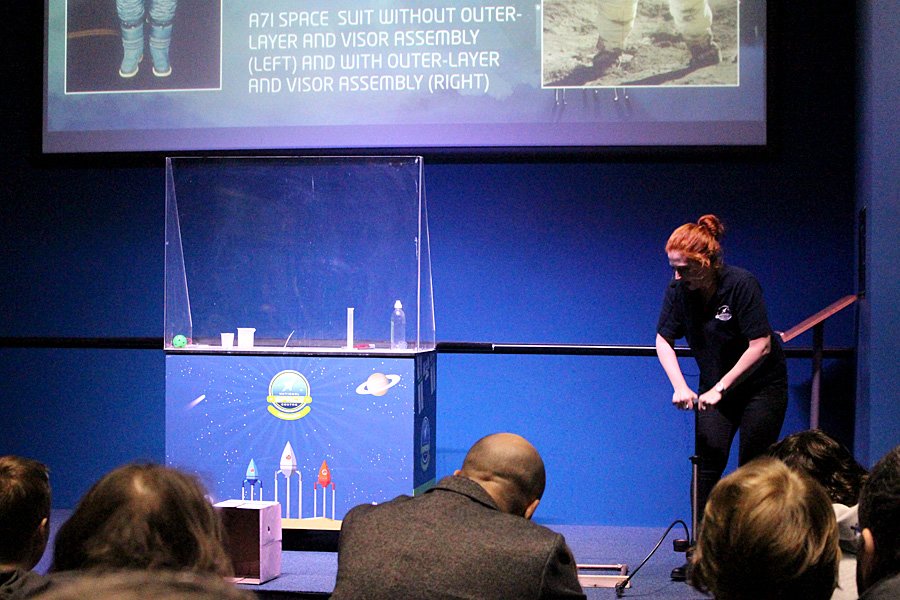
This part of the building can get quite loud with occasional loud bangs during demonstrations, so those affected by sudden, loud noises are advised to avoid these shows. I noticed a prominent sign by the entrance on our arrival which warned that loud bangs would be occurring throughout the day and advised visitors not to be alarmed. Given the heightened security at most tourist attractions these days, this was nice to see as some of the bangs from the show (which occurred several times throughout the day) were loud enough to make us jump from across the building.
Tranquility Base
The final section of the National Space Centre is Tranquility Base. For this section, you will need your free paper pass again if you want to track your training. Tranquility Base asks you to imagine you are a trainee astronaut on a lunar base in 2025 and is made up of various stations, by visiting each one you will go through Space Cadet Training. The activities are open to everyone, adults included, and by scanning the barcode on your passes, you can each track your own individual training journeys.

The activities in Tranquility Base include loading a shuttle up with the right kinds of supplies, mining moon rock, controlling life support systems as a team, operating jet boosters, and going through a “medical screening”. Once you’ve completed each station (or as many as you want/can depending on how busy the area is), you can head over to Astronaut Assessment and be given a role at the lunar base. At the end of my training, I was assigned the role of Life Support Engineer – Heaven help everybody if I’m in charge given my abysmal performance on the Life Support Systems activity!
Events at the National Space Centre
In addition to all the regular activities at the National Space Centre, there are always a number of special events taking place. Some of these events are included with regular day and annual passes, while some are premium and will incur an additional fee. Some of the special events taking place over summer 2019 include:
- One Giant Leap (12th July – 1st September) – An “immersive celebration of the Apollo 11 50th anniversary”. See real lunar rocks, make your own Apollo mission patch, and watch the Eagle land with live narration over the original NASA footage.
- Dark Side of the Moon (11th – 12th July) – Darkside The Pink Floyd Show play live in the Sir Patrick Moore Planetarium. Premium Event.
- Space Lates (20th July) – Celebrate the 50th anniversary of Apollo 11 landing on the moon by sleeping over at the National Space Centre. During the evening participate in a 60s silent disco, try liquid nitrogen ice cream, and listen to talks from experts. Later on, there will be tabletop gaming in the cafe to keep those who want to stay up awake until 3.45am when “live” footage of the moon landing will be shown inside the planetarium. Premium Event
- Alien 40th Anniversary Screening (6th September) – Screening in the Planetarium. Premium Event.
- Small Space Teddy Bear Day (9th September) – A special early year’s development day with no schools or groups on the premises and lots of events and activities catered for the littlest explorers.
Should You Visit the National Space Centre?
Yes, absolutely.
If you have kids who are interested in space then the National Space Centre should be top of your list of UK attractions to visit. While nothing here has quite the same wow factor as seeing a real Saturn V or Space Shuttle at Kennedy Space Center, there’s a tremendous amount packed into this building. If your kids, like mine, aren’t huge fans of all things out of this world, then they’ll still find plenty to keep them entertained. My son loved the planetarium film and the fact that he could get hands-on and mess around with most of the displays. He spent a solid 15 minutes sending balls spinning into a mock black hole and I kept spotting him reading information panels to learn more when he thought I wasn’t looking, In fact, in our whole day he never once asked for his phone – an achievement even Disneyland Paris couldn’t match!
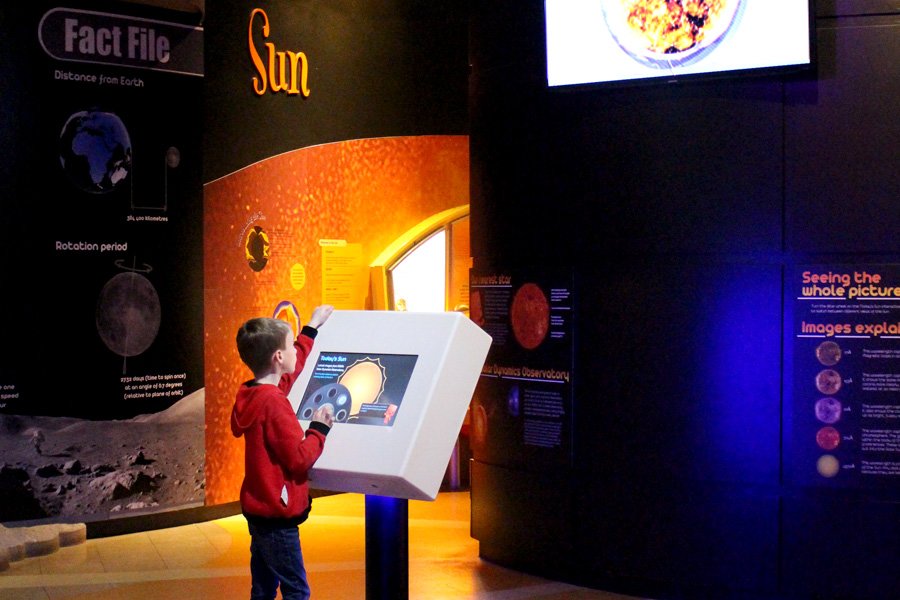
We visited the National Space Centre as a three-generation group and everyone in our family loved it. My mum, who remembers watching the moon landing in 1969, loved the Rocket Tower and seeing the historical side of things and how they have changed from the Apollo program to Tim Peake’s Principia mission. My son loved the interactive displays, while my husband and I enjoyed a mixture of everything – both of us were very taken with some, admittedly rather dated, videos about the life cycle of stars that had a strong Douglas Adams vibe about them.
The National Space Centre is a great day out for families and there are enough hands-on activities to keep kids of all ages interested. We arrived before the doors opened the day we visited and were still there an hour before closing, even with just one planetarium show in our schedule so there’s plenty to do, despite the building looking small when you first arrive. Given how well-priced tickets are, this really is an attraction I can highly recommend.
GeekMom received entry to the National Space Centre for review purposes.


